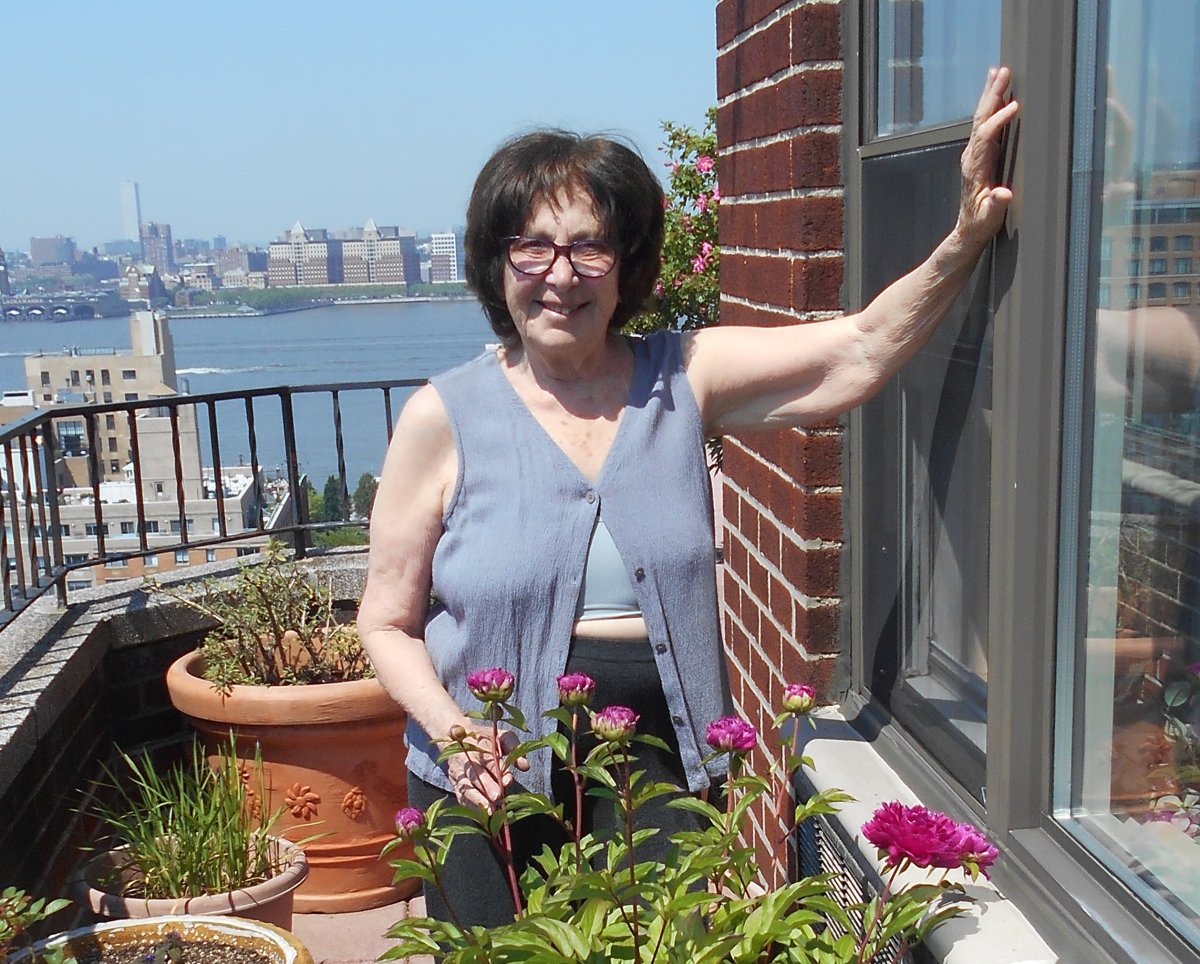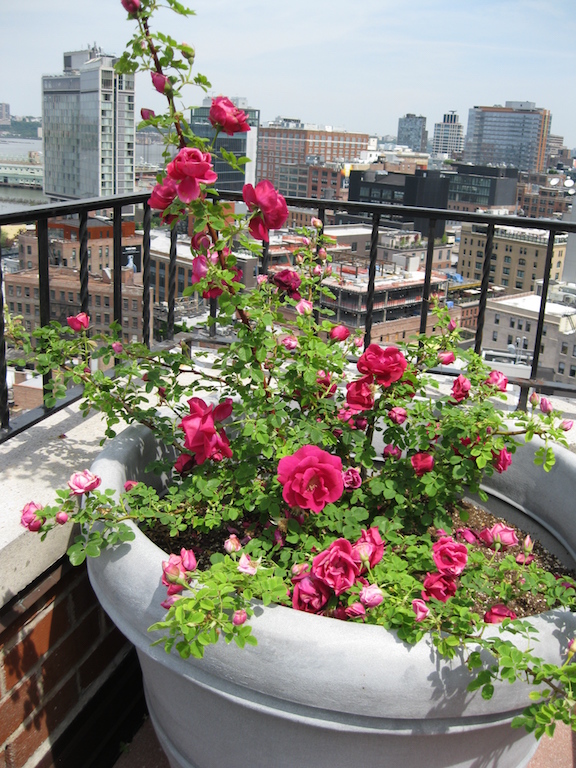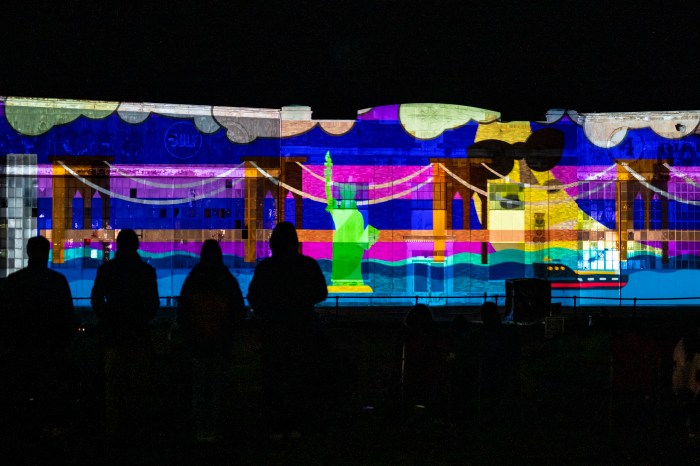
BY SUSAN BROWNMILLER | Landscape designers often propose adding a man-made “water feature” to a country estate for visual interest, lively motion and calming sounds. The options include dredging and filling a pond or a lake, or creating a stepped waterfall and a brook. A fountain that recycles its water is recommended for a small city garden. My garden’s water feature is a great stretch of the Hudson River that I am privileged to see from my terrace.
As it flows past the island of Manhattan, the Hudson forms a geographical boundary between New York and New Jersey, and gives me a nodding acquaintance with the mushrooming skylines of Hoboken and Jersey City. On their side of the river, Jersey folks see Manhattan’s skyline from their perspective. If I look north, I can still catch a glimpse of the Palisades, the rocky cliffs formed in the Triassic Period, though they are increasingly obscured by high-rises on both sides of the Hudson.
Looking south, I follow the river as it widens and pours into the gleaming upper bay of New York Harbor, once the heart of the commercial Port of New York and New Jersey. A small island in the bay belongs to “The Lady,” the name air-traffic controllers and harbormasters bestowed on the Statue of Liberty. No other sight has inspired more hope, extended such grave assurance of protection, or is more unconventionally beautiful than her singular presence, her torch held high to welcome immigrants who made the long Atlantic passage to better their lives. My view of America’s freedom icon is fairly distant. I can make out her uplifted arm and torch, her spiked helmet, the folds of her skirt, and supply the details of her vigilant gaze and worried brow from postcards and memory. Even on days of poor visibility, I feel reassured that The Lady is commanding the harbor.
Beyond the curve of the shore, past my vista, the Hudson concludes the journey it began upstate in Adirondack Mountain streams by joining the East River and other urban waterways to flow into the Atlantic Ocean.
Manhattan’s waterfront does not bear much resemblance to the active port it used to be. Luxury ocean liners and their terminals started to dwindle in the latter half of the 20th century when jets became the quick, affordable way to travel. In another blow, the automated docks of Newark Bay lured container shipping from Manhattan’s labor-intensive cargo piers. During this same half-century, the Hudson acquired a deserved reputation for being polluted and stinky, a disaster area of industrial waste, PCBs, dead fish, lost spawning grounds and raw sewage. The Left’s folksinging hero Pete Seeger found a new cause in cleaning up the river; his sloop the Clearwater was an inspiration for other environmental activists who created a tidal wave of lawsuits to enlighten government thinking about the stewardship of rivers and aquatic life.

Today the largest vessels that ply a much cleaner river are the brightly painted, multi-decked cruise ships of the Norwegian, Carnival, Holland America and Princess lines that depart from Midtown terminals to take passengers on short Caribbean holidays. The cruise ships alert smaller craft to their presence by a sonorous blast that makes me stop whatever I’m doing to watch them pass. For a while Disney had ships that tooted “When you wish upon a star” in the halting meter of a kid playing a church organ.
Smaller boats move up, down and across the blue-gray water, leaving their own white wake. Circle Line and Spirit of New York tour boats glide past the many hulking skylines of Manhattan, squat commuter ferries chug to and from Staten Island, excursion boats take sightseers to Ellis and Liberty islands. I see oil tankers and cement barges accompanied by tugs, private yachts and fishing boats, billowing white sailboats, yellow water taxis, outriggers, kayaks and canoes, and preening fireboats that are testing their sprays. Sleek fiberglass “cigarette boats” race by in diminishing numbers. Once I saw a gray and ghostly battleship that may have been on a journey to be scrapped for its metal. I was not yet in residence for the Parade of Tall Ships from around the world that honored the 1976 Bicentennial, but I had my private viewing platform for the bigger procession of barques and brigantines that arrived to honor the Statue of Liberty’s centennial a decade later.
I get a kick whenever I see the tide move “backwards” up the river, as it does twice a day for periods of more than six hours, propelling saltwater north from the ocean; if the wind is blowing inland I can smell the salt. After an upstream run, the river changes its course to run south for a similar amount of time. The more powerful downstream tide carries fresh water to the sea. And then the cycle is repeated in the Hudson’s estuarial pattern. A solid knowledge of tides and currents is important for boat navigation; I am just an observer of surface flow.
Plenty of action takes place in the sky; I find much of it unpleasant. My water feature lies midway in an air corridor for small planes and helicopters on various missions: escorting sightseers and Financial District commuters, advertising products, performing security surveillance for high-profile events. Officially called the Hudson River Flyway, the air corridor is the 15-mile strip between the George Washington Bridge and the Verrazano Bridge, where the river passes through the Narrows to reach the ocean. For everyone’s safety, small craft are directed to fly at altitudes below 1,300 feet while big jets command the sky at 30,000 feet and higher. Small-craft pilots are supposed to follow the “visual flight rules” — stay over the water, hew to a shoreline, keep your radio tuned to a frequency for traffic advisories. Travel time in one direction on the flyway is seven minutes if the pilot doesn’t dawdle near The Lady. Once I saw a weekend warrior in a biplane — weekend warriors are what these idiots are called — swerve inland to buzz a building for fun.
On Tuesday morning, Sept. 11, 2001, I was sipping coffee and reading the paper when a friend called at 9 am: “Look out your window — I heard on the radio that a small plane crashed into the World Trade Center.” That was how the news of terrorist hijackers was first reported. “A small plane may have lost control… .” I looked out my window, past my roses and the expanse of Greenwich Village, toward the Twin Towers, a looming presence vastly out of scale with the rest of the Lower Manhattan skyline. The top half of one tower was engulfed in flames. As I stared, unbelieving, a second jet dived into the other tower. Oh my god!
One tower collapsed at 10 a.m. The other tower fell a half-hour later. Everything was surreal, like Jean Cocteau’s “The Blood of the Poet,” a silent black-and-white film with repeated images of a crumbling tower. The color TV in my bedroom kept replaying the footage of the crumbling Twin Towers. Sirens wailed as ambulances from St. Vincent’s hospital sped Downtown to collect the injured who might have survived. The president addressed the nation at 8:30 that evening. By then the air had become fetid with the dust of pulverized humans and my apartment was filled with friends who were stranded and couldn’t get home. Some of them slept over.
Sorry to have gone on about 9/11 in a garden book, but I could not suppress what I witnessed that day from my penthouse aerie near the Hudson River.
Sightseeing helicopters have become hugely profitable for entrepreneurs on both sides of the Hudson. I hear the noise from the engines and the whirring blades before the choppers come into view. The sound fills me with dread from another era: the whirring Huey gunships of the Vietnam War that I saw every night on the TV news. I am not the only person to hate the choppers. They are also big carbon dioxide polluters and a few environmental groups and politicians are calling for their ban. Good luck.
An infrequent but wondrous sight in winter, if we’ve had a spell of subfreezing weather, are the ice formations on the river’s two shores that look like they might meet in the middle, giving me sweet dreams of skating to New Jersey. The jagged floes never do converge. If they did, the Coast Guard ice patrol would break them up swiftly to keep commercial traffic moving. On overcast, misty summer mornings the river presents another wondrous aspect: It becomes a long sheet of gray glass, a mirror that reflects the shape of the tall buildings on the opposite shore.
Fireworks pop up unexpectedly here and there on summer evenings, launched from a single barge for the enjoyment of invited guests on a nearby pleasure boat. Single-barge fireworks are paid for by folks that want to celebrate something — a wedding, an engagement, an anniversary, a birthday — with a big bang. The permit alone costs $50,000. Gay Pride Week in June used to end with fireworks from a barge right in front of me; the show started fashionably late at 10:20 p.m.
After all these years I am pretty blasé about single-barge fireworks. That’s because the best show of all for lighting up the sky is Macy’s annual Fourth of July display that is often, but not always, fired from four synchronized barges between Chelsea and the mid-40s. When I moved to this penthouse, Macy’s gift to the city turned me into a Fourth of July party giver, with all the attendant anxiety one has over hosting an outdoor event. Will it rain and be a washout? There were only two washouts in all the Fourths that Macy’s and I have put on. The sweetest moment of the evening, in my opinion, comes after the grand finale, after the last whistle and boom of exploding chrysanthemums, peonies, rings, hearts and palms (and the last ooohs and ahhhs from my guests) when hundreds of pleasure boats that gathered on the river to watch the show begin their voyage home in the suddenly quiet dark. (In the last couple of years Macy’s has switched to the East River for its fireworks extravaganza. I hope they return to my river soon.)
I’m lucky to still see as much of the Hudson as I do. Every year a few more high-rises spring up between the river and me on land that used to house factories and meatpacking plants outside the protection of the Greenwich Village Historic District. The city and some private interests have concocted grand plans for the derelict wood pilings that used to support working piers. Pier 54 was torn town for an amphitheater that will jut into the river. Pier 40, the site of a neighborhood soccer field, tennis courts and dog runs, is up for grabs. The Whitney Museum built a new home on Meatpacking District land in front of my eyes. After the cleverly designed structure opened to the public, I begrudgingly warmed to having an art museum close by and took out a membership even though the damn thing blocked a chunk of my river view.
It is an axiom of city life that people in tall buildings with astonishing but unprotected views will find their vistas obstructed by newer and taller buildings. Nobody owes me a sweeping view of the Hudson. One day, maybe in my lifetime, there won’t be a river view from this terrace at all.
Quoting Ralph Waldo Emerson, circa 1846: “Who looks upon a river in a meditative hour and is not reminded of the flux of all things?”
Excerpted from Susan Brownmiller’s new book, “My City Highrise Garden” (Rutgers University Press)

















